Java Island (Indonesia): Unveiling the Hidden Gems of Tropical Paradise
Discover Indonesia's Java Island: A Treasure Trove of Tropical Wonders
Discover the hidden gems of Java Island, Indonesia. Uncover the best places to visit and experience the tropical paradise. Plan your trip now! #JavaIsland
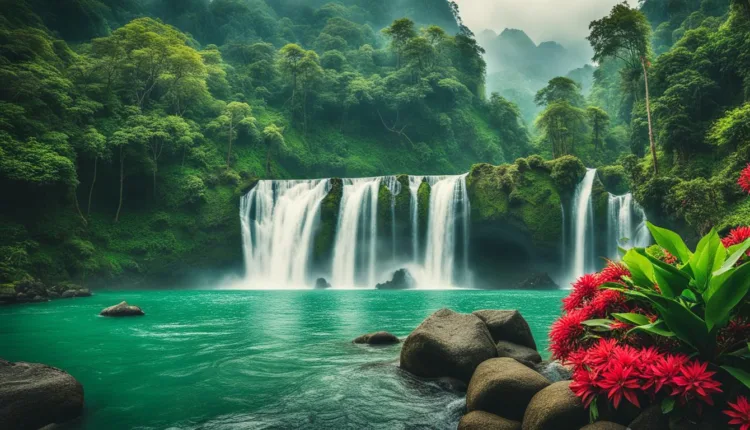
As a travel advisor, I am thrilled to introduce you to the breathtaking Java Island, a tropical paradise nestled in Indonesia. With its vibrant landscapes, rich cultural heritage, and historical treasures, Java Island offers an unforgettable experience for all travelers. From ancient temples and pristine beaches to volcanic wonders, Java Island is a treasure trove of hidden gems waiting to be discovered.
Key Takeaways:
-
Java Island is a tropical paradise in Indonesia, offering diverse landscapes and vibrant communities.
-
Explore ancient temples, pristine beaches, and volcanic wonders on Java Island.
-
Java Island has a fascinating history, from ancient Javanese kingdoms to Dutch colonial rule and Indonesian independence.
-
Located in Southeast Asia, Java Island is the most populous island in Indonesia.
-
The best time to visit Java Island depends on the weather preferences of the traveler.
History of Java Island
The history of Java Island is a captivating tale that spans centuries, shaped by the rise and fall of Javanese kingdoms, centuries of Dutch colonial rule, and Indonesia’s journey towards independence. This rich historical backdrop has left its mark on the island, with ancient temples, architectural marvels, and cultural traditions that continue to thrive today.
Java Island’s history dates back to the ancient Javanese kingdoms, such as the Mataram and Majapahit empires, which flourished from the 8th to the 15th centuries. These kingdoms were centers of trade and culture, leaving behind impressive temple complexes and vibrant artistic traditions.
The arrival of the Dutch in the 16th century marked a new chapter in Java’s history. The Dutch East India Company established a strong presence on the island and gradually gained control over the entire archipelago. Dutch colonial rule had a profound impact on Java, shaping its economy, infrastructure, and society. Plantations were established, and labor was exploited, leading to significant changes in the demographic and social fabric of the island.
The 20th century brought a wave of nationalist movements, culminating in Indonesia’s declaration of independence in 1945. Java Island played a central role in the struggle for independence, with key figures such as Sukarno and Hatta emerging as leaders of the movement. The fight for independence had a lasting impact on Java’s identity and the trajectory of the nation.
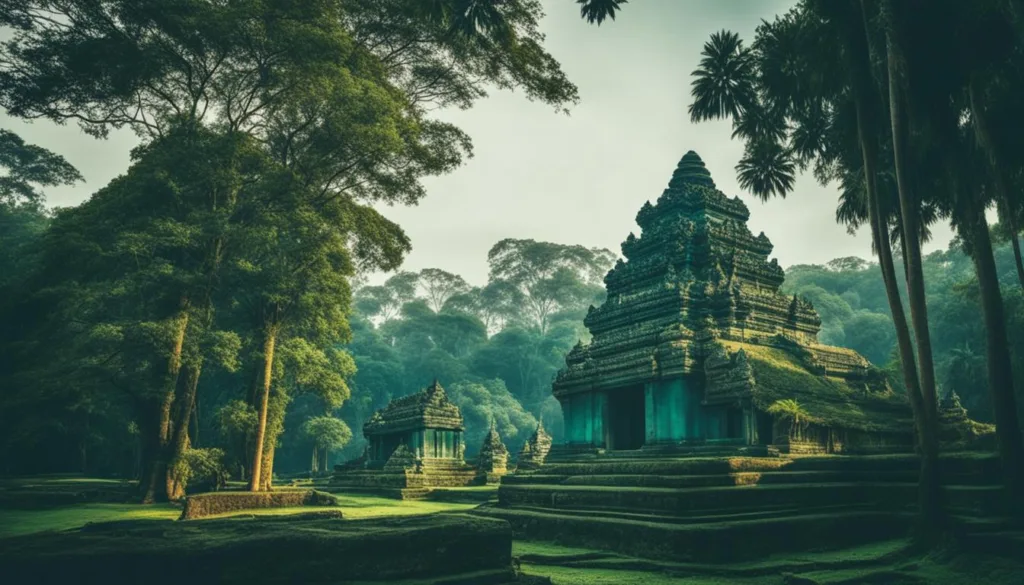
Today, Java Island stands as a testament to its complex and diverse history. Its ancient temples, Dutch colonial architecture, and vibrant cultural heritage continue to attract visitors from around the globe, offering a glimpse into the island’s rich past.
Location of Java Island
Java Island is located in Southeast Asia and is an integral part of Indonesia, the largest archipelago in the world. It is situated between the Indian Ocean to the south and the Java Sea to the north. Java Island boasts a strategic location and is bordered by several significant bodies of water, including the Sunda Strait to the west, the Bali Strait to the east, and the Java Trench to the south.
The island spans approximately 139,000 square kilometers, making it the world’s 13th largest island. It is also the most populous island in Indonesia, with over 140 million people calling it home. Jakarta, the capital city of Indonesia, is located on the northwestern coast of Java Island. This bustling metropolis serves as a gateway to the island and offers an intriguing blend of modernity and rich cultural heritage.
In addition to Jakarta, there are other major cities on Java Island that are worth exploring. Yogyakarta, often referred to as the cultural capital of Java, is known for its vibrant arts scene, ancient temples, and traditional Javanese culture. Surabaya, the second-largest city in Indonesia, is an important economic hub and a melting pot of diverse cultures.
| City | Province | Notable Attractions |
|---|---|---|
| Jakarta | Special Capital Region of Jakarta | National Monument, Ancol Dreamland, Kota Tua |
| Yogyakarta | Special Region of Yogyakarta | Borobudur Temple, Prambanan Temple, Kraton Yogyakarta |
| Surabaya | East Java | Mount Bromo, Suramadu Bridge, House of Sampoerna |
To the east of Java Island lies Bali, one of the most popular tourist destinations in Indonesia. Bali offers a unique blend of stunning beaches, vibrant culture, and lush landscapes. Many travelers choose to combine their visit to Java Island with a trip to Bali to experience the best of both worlds.
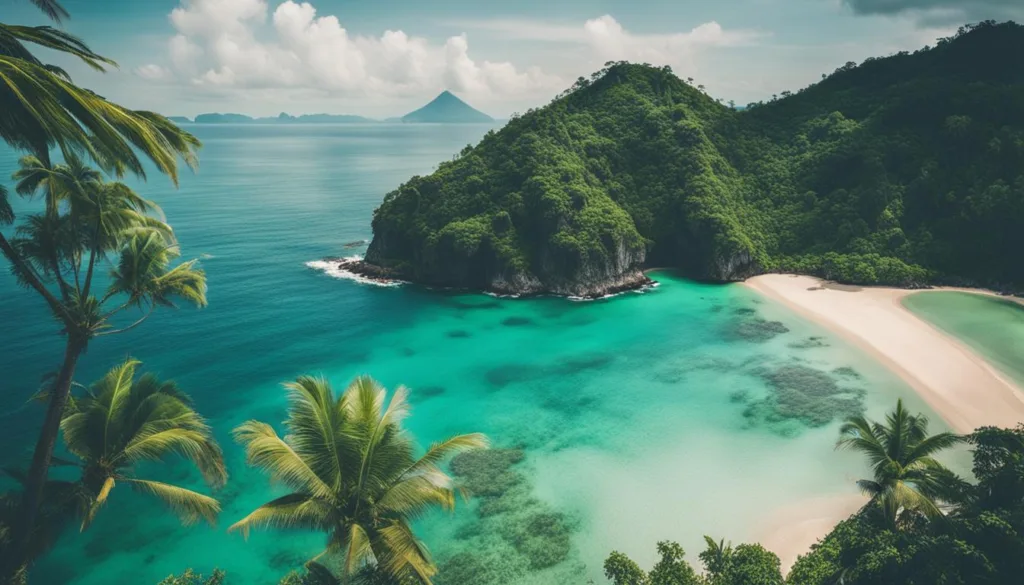
“Java Island’s strategic location in Southeast Asia makes it easily accessible from neighboring countries. Its diverse cities and breathtaking landscapes make it a must-visit destination for travelers seeking both cultural immersion and natural beauty in one place.”
Read More: São Vicente Island (Cape Verde)
Best Time to Visit Java
When planning a trip to Java Island, it is essential to consider the best time to visit to make the most of your travel experience. The island’s tropical climate offers two distinct seasons: the dry season and the wet season. Each season has its own unique charm and advantages, depending on your preferences.
The dry season, which runs from April to October, is considered the best time to visit Java. During this period, the weather is generally pleasant, with warm temperatures and minimal rainfall. This makes it ideal for exploring the island’s attractions, such as the ancient temples, pristine beaches, and volcanic wonders. The dry season also attracts a larger number of tourists, so it is advisable to plan your itinerary in advance and expect some crowds at popular sites.
On the other hand, the wet season, from November to March, offers a more relaxed and budget-friendly experience. While rainfall is more frequent during this time, it usually occurs in short bursts, allowing for plenty of sunny spells in between. The wet season also offers the opportunity to witness the lush green landscapes of Java in their full glory, as the rainfall rejuvenates the vegetation. If you don’t mind occasional rain showers and want to avoid the peak tourist season, the wet season can be a great time to visit.
| Season | Best Time to Visit | Advantages |
|---|---|---|
| Dry Season | April to October | Pleasant weather, minimal rainfall, ideal for exploration |
| Wet Season | November to March | Relaxed experience, budget-friendly, lush vegetation |
| Transition Months | March and November | Favorable weather, fewer tourists |
The transition months of March and November offer a balance between the dry and wet seasons. During these months, the weather is generally favorable, with fewer tourists compared to the peak season. It can be a great time to visit if you prefer moderate crowds and pleasant weather.
In conclusion, the best time to visit Java depends on your preferences. Whether you choose to explore the island during the dry season for pleasant weather or during the wet season for a more relaxed experience, Java’s natural wonders and cultural treasures are sure to captivate you throughout the year.
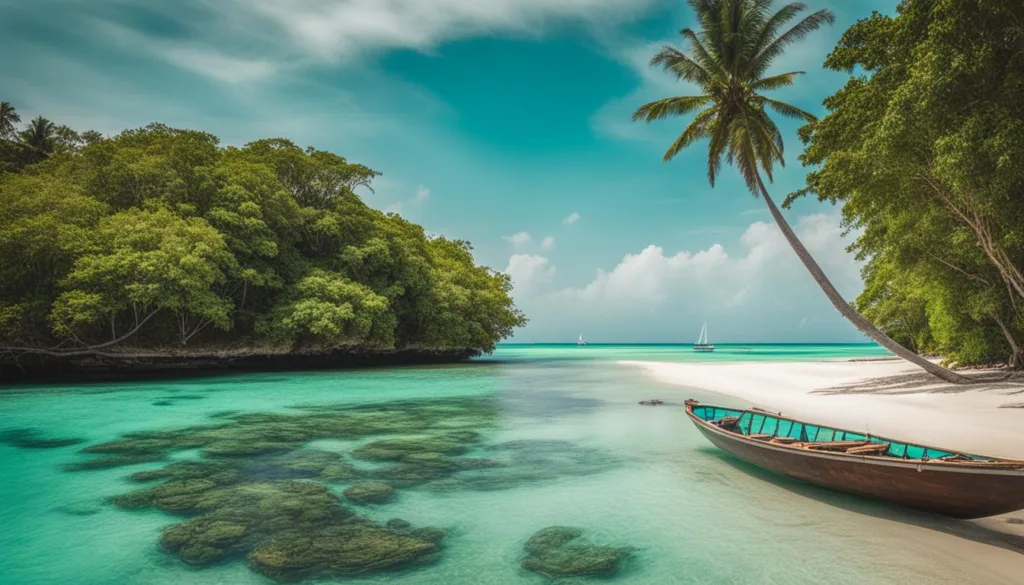
With its pristine shores, vibrant marine life, and a variety of activities to choose from, the Karimunjawa Islands are a true paradise for beach lovers and water sports enthusiasts. Whether you’re seeking relaxation or adventure, these secluded islands offer an unforgettable experience.
Table: Water Sports in Karimunjawa Islands
| Activity | Description |
|---|---|
| Snorkeling | Explore the vibrant coral reefs and encounter a wide variety of marine life. |
| Diving | Discover the underwater wonders of the Karimunjawa Islands with experienced dive instructors. |
| Kayaking | Paddle through the stunning mangroves and discover hidden coves and beaches. |
| Fishing | Experience the thrill of deep-sea fishing and try to catch your own dinner. |
Whether you’re a beach lover or an adventure seeker, the Karimunjawa Islands offer something for everyone. Immerse yourself in the beauty of this secluded tropical paradise and create memories that will last a lifetime.
Kawah Ijen – The Blue Flames of Wonder
The island of Java is home to many natural wonders, but one that stands out for its mesmerizing beauty is Kawah Ijen, a volcanic crater located in East Java. What makes Kawah Ijen truly unique is its breathtaking blue fire phenomenon, creating a surreal spectacle that attracts scientists and adventurers from around the world.
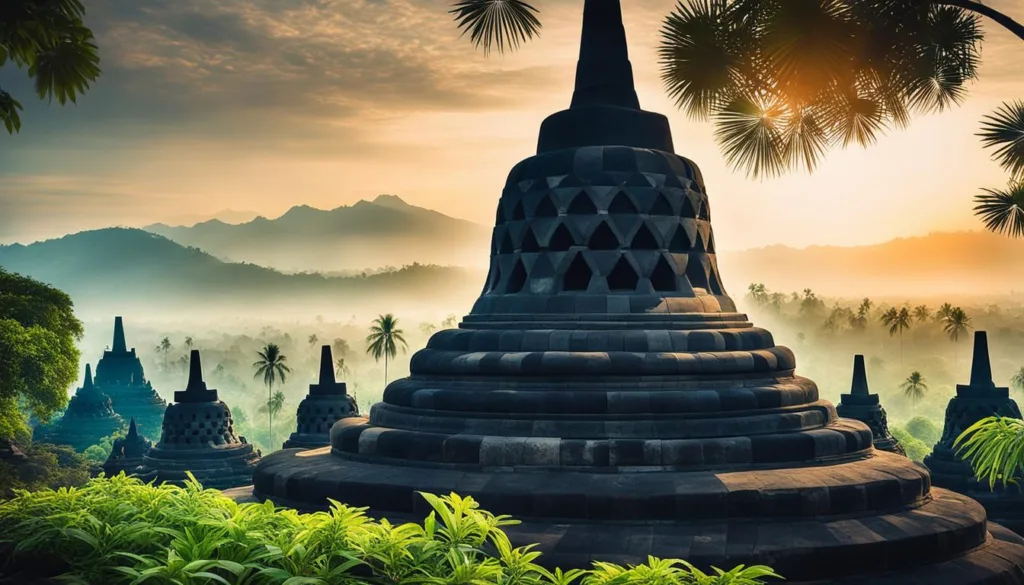
The Borobudur Temple sits atop a hill and consists of nine stacked platforms, with the top platform crowned by a central stupa. The entire structure is adorned with more than 2,600 relief panels and over 500 Buddha statues. These intricate carvings depict scenes from Buddhist scriptures and teachings, offering a glimpse into the rich symbolism and spiritual beliefs of the time. The temple’s layout represents the Buddhist concept of the cosmos, with its three levels symbolizing the realms of desire, form, and formlessness.
Visitors can explore the temple’s three main levels, each representing a different stage of Buddhist enlightenment. As they ascend, they are guided through a journey from the earthly realm to the realm of Nirvana. The climb is a symbolic pilgrimage, and many visitors use this opportunity for personal reflection and meditation.
Key facts about Borobudur Temple:
-
Location: Yogyakarta, Central Java, Indonesia
-
Constructed: 8th and 9th centuries
-
Architectural Style: Javanese Buddhist
-
Dimensions: 34.5 meters (113 ft) tall, 123 x 123 meters (404 x 404 ft) at the base
-
Reliefs: Over 2,600 relief panels depicting Buddhist narratives
-
Buddha Statues: More than 500 Buddha statues
-
UNESCO World Heritage site: Inscribed in 1991
Exploring the Borobudur Temple is an awe-inspiring experience that allows visitors to immerse themselves in the history, culture, and spirituality of Java Island. The combination of its architectural grandeur, intricate carvings, and serene surroundings creates a sense of tranquility and wonder. Whether you are a history enthusiast, a spiritual seeker, or simply a lover of art and culture, a visit to Borobudur Temple is sure to be a highlight of your journey through Java Island.
Prambanan Temple – A Marvelous Hindu Complex
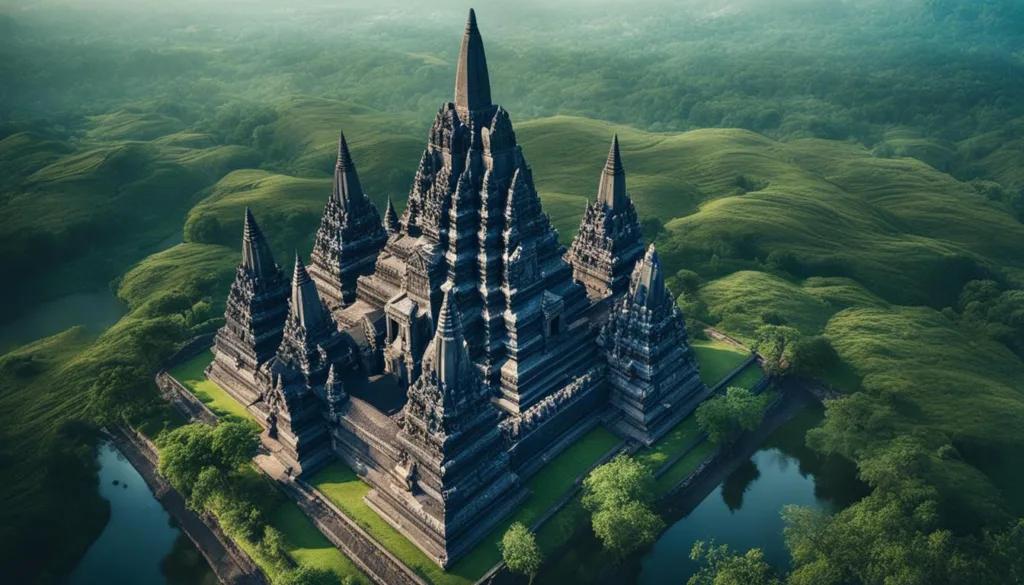
Welcome to Prambanan Temple, one of the most magnificent Hindu temple complexes in Southeast Asia. Located in Central Java, this architectural marvel is a testament to the rich history and cultural heritage of Java Island.
Prambanan Temple dates back to the 9th century and is dedicated to the Trimurti deities of Hinduism: Brahma, Vishnu, and Shiva. The temple complex consists of towering spires adorned with intricate carvings, depicting mythical tales and celestial beings. Walking through these sacred grounds is like stepping into a world of ancient legends and spiritual devotion.
“Prambanan Temple is a testament to the skill and craftsmanship of ancient Javanese artisans. Its intricate carvings and towering structures leave visitors in awe.”
As you explore the temple complex, you’ll be mesmerized by the grandeur of the main temple, dedicated to Lord Shiva. Standing at over 47 meters high, it is the tallest Hindu temple in Indonesia. Surrounding the main temple are numerous smaller shrines, each with its own unique architectural features and religious significance.
Prambanan Temple is not just a historical site; it is also an important place of worship and pilgrimage for Hindus. The temple complex comes alive during religious festivals, where devotees gather to pay their respects and participate in sacred rituals.
The Cultural Significance of Prambanan Temple
Prambanan Temple holds immense cultural significance for the people of Java and Indonesia as a whole. It serves as a reminder of the region’s rich past and the deep-rooted traditions that have shaped the island’s identity. The temple complex has been recognized as a UNESCO World Heritage site, further highlighting its importance and ensuring its preservation for future generations.
Plan Your Visit to Prambanan Temple
To fully appreciate the beauty and historical significance of Prambanan Temple, it is recommended to allocate ample time for exploration. Guided tours are available, providing insights into the temple’s architecture, mythology, and cultural significance. Don’t forget to capture the breathtaking views and intricate details with your camera.
As you immerse yourself in the magical ambiance of Prambanan Temple, take a moment to reflect on the centuries of history that have shaped the island of Java and the vibrant cultures that call it home. Prambanan Temple is a must-visit for anyone seeking a deeper understanding of Indonesia’s cultural heritage.
Experience the wonder of Prambanan Temple – a testament to human creativity, devotion, and the enduring legacy of Java Island.
Bandung – The Paris of Java
Welcome to Bandung, the “Paris of Java,” where a cool climate, lush tea plantations, and an array of factory outlets await you. Nestled in the scenic landscapes of West Java, this vibrant city offers a unique blend of natural beauty and urban charm, making it the perfect destination for relaxation and exploration.
The cool climate of Bandung sets it apart from the rest of Java, providing a refreshing escape from the tropical heat. Surrounded by stunning mountain ranges and verdant tea plantations, the city offers breathtaking panoramic views that will leave you in awe. Immerse yourself in the tranquility of nature as you explore the picturesque landscapes and enjoy a cup of freshly brewed tea from the local plantations.
“Bandung, the capital of West Java, is known as the ‘Paris of Java’ due to its cool climate and unique blend of natural beauty and urban charm.”
For the fashion-conscious traveler, Bandung is a paradise for shopping enthusiasts. The city is famous for its numerous factory outlets, where you can find a wide range of clothing, accessories, and home decor at discounted prices. Indulge in a shopping spree as you explore the vibrant streets and discover the latest fashion trends.
| Attractions | Description |
|---|---|
| Tangkuban Perahu | A dormant volcano with a unique shape, perfect for hiking and enjoying panoramic views of the surrounding landscapes. |
| Trans Studio Bandung | Indonesia’s largest indoor theme park, offering thrilling rides and entertainment for the whole family. |
| Paris Van Java | An upscale shopping mall known for its stylish architecture, international brands, and trendy cafes. |
Indulge in the local cuisine as you explore Bandung’s vibrant food scene. The city is famous for its mouthwatering street food, where you can sample traditional delicacies such as mie kocok (beef noodle soup), sate maranggi (grilled meat skewers), and pisang molen (banana-filled pastry). Don’t forget to visit the famous Floating Market Lembang, where you can enjoy a unique dining experience on traditional boats.
Bandung offers a multitude of cultural and historical attractions as well. Explore the Gedung Sate, an iconic government building that showcases Dutch colonial architecture, or visit the Asian-African Conference Museum, which commemorates the historic event that took place in Bandung in 1955. Immerse yourself in the rich heritage and traditions of the Sundanese people at Saung Angklung Udjo, where you can witness traditional music and dance performances.
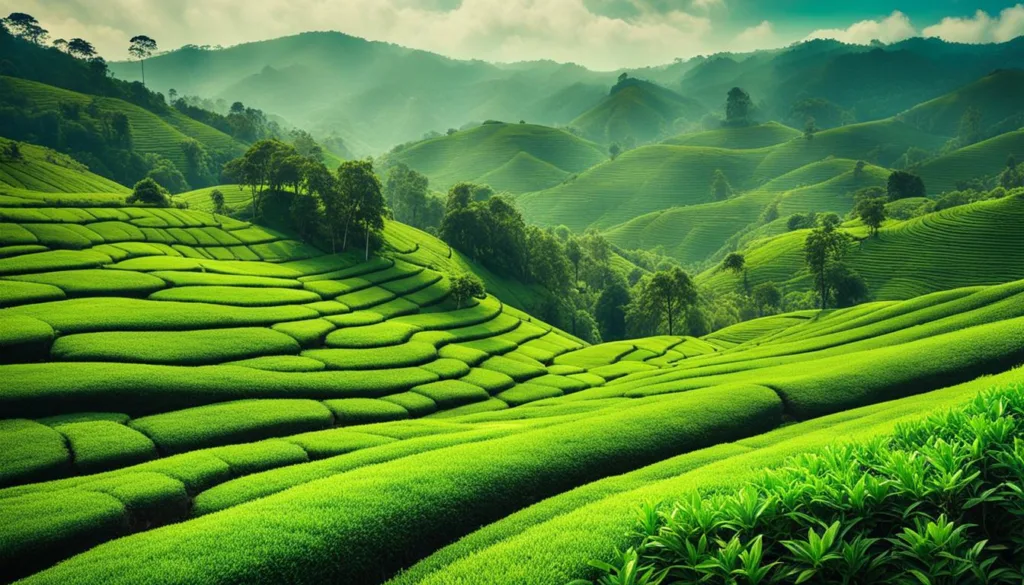
Discover Bandung – The City of Charm
Bandung, with its cool climate, lush tea plantations, and factory outlets, offers a truly enchanting experience in the heart of Java. Whether you are seeking relaxation, adventure, or a taste of local culture, this vibrant city has something to offer every visitor. Plan your journey to Bandung and immerse yourself in the beauty and charm of the “Paris of Java.”
Dieng Plateau – A Mystical Highland Region
The Dieng Plateau is a breathtaking highland region nestled in the heart of Central Java. Perched at an elevated location of 2,000 meters above sea level, this mystical destination offers a unique blend of ancient temples, captivating landscapes, and volcanic wonders. It is a place where history, spirituality, and natural beauty converge, providing visitors with a truly unforgettable experience.
The Dieng Plateau is renowned for its impressive collection of ancient temples. Dating back to the 8th and 9th centuries, these temples showcase the architectural prowess of the Javanese civilization. The Arjuna Temple Complex, in particular, is a remarkable site with its intricately carved stone structures and ornate decorations.
As you explore the Dieng Plateau, you will be greeted by the awe-inspiring volcanic landscapes that surround you. From the mist-covered craters to the geothermal springs, every corner of this region exudes a sense of otherworldly charm. The most notable volcanic feature is the Telaga Warna, or the Colorful Lake, which boasts an enchanting palette of vibrant hues.
| Ancient Temples | Elevated Location | Volcanic Landscapes |
|---|---|---|
| Dieng Plateau is home to ancient temples dating back to the 8th and 9th centuries. | Perched at an elevated location of 2,000 meters above sea level, offering stunning panoramic views. | The region is characterized by mesmerizing volcanic landscapes, with mist-covered craters and geothermal springs. |
“The Dieng Plateau is a hidden gem in Central Java, offering a mystical retreat for those seeking ancient history and natural wonders. Its ancient temples, elevated location, and volcanic landscapes make it a truly enchanting destination.”
Visiting the Dieng Plateau provides not only a visual feast but also a spiritual journey. The locals believe that the mist that often envelops the landscape is the manifestation of ancestral spirits, creating an ethereal ambiance. The high elevation also adds to the tranquility, allowing you to escape the hustle and bustle of everyday life.
Whether you are an avid history enthusiast, a nature lover, or a spiritual seeker, the Dieng Plateau offers something truly extraordinary. Immerse yourself in the ancient temples, breathe in the cool mountain air, and witness the raw power of the volcanic landscapes. A visit to this mystical highland region will leave you with a deep sense of wonder and a lasting connection to the rich culture and natural beauty of Java.
Merapi Volcano – A Fiery Giant
Java Island is home to one of the world’s most active and iconic volcanoes, Merapi Volcano. Known as the “Mountain of Fire,” Merapi Volcano is a breathtaking natural wonder that has shaped the landscape and influenced the local traditions of Central Java. Its imposing presence and explosive nature make it a must-visit destination for adventure seekers and nature enthusiasts.
One of the most thrilling activities for visitors is trekking up the slopes of Merapi Volcano. The challenging hike offers panoramic views of the surrounding countryside and a chance to witness the raw power of this active volcano. As you ascend, you’ll be rewarded with awe-inspiring vistas and a sense of accomplishment that can only come from conquering such a formidable natural force.
“Merapi Volcano is not just an active volcano; it is a symbol of strength and resilience for the people of Java. Its eruptions have shaped the landscape and influenced the local traditions and beliefs. It is a place where nature and spirituality intersect, creating a unique and powerful experience,” says a local guide.
Beyond the physical beauty and adventure, Merapi Volcano holds deep cultural significance for the people of Java. It is believed to be the abode of spiritual beings and is an integral part of local traditions and rituals. Visitors have the opportunity to learn about these traditions and the volcano’s impact on the lives of the local communities.
As you explore Java Island, don’t miss the opportunity to witness the majestic Merapi Volcano. It is an experience that will leave you in awe of the raw power of nature and the rich cultural heritage of the Javanese people.

Trekking Routes on Merapi Volcano:
| Route | Difficulty | Duration |
|---|---|---|
| Trail A – Selo Route | Challenging | 6-7 hours |
| Trail B – Kaliurang Route | Moderate | 4-5 hours |
| Trail C – Pakem Route | Moderate | 4-5 hours |
| Trail D – Deles Route | Easy | 3-4 hours |
Kalibiru National Park – A Serene Retreat
I recently discovered Kalibiru National Park, a hidden gem nestled in the Menoreh Hills of Yogyakarta. This serene retreat offers a peaceful escape into nature, surrounded by lush forests and breathtaking panoramic vistas. Whether you’re an adventure seeker or simply looking for a tranquil getaway, Kalibiru National Park has something for everyone.
One of the highlights of Kalibiru National Park is its elevated viewpoints, which provide stunning views of the surrounding landscapes. From here, you can witness the beauty of the Menoreh Hills, the sprawling forests, and even catch a glimpse of the distant mountains. It’s truly a feast for the eyes and a perfect spot for nature lovers and photography enthusiasts.
What sets Kalibiru National Park apart is its commitment to eco-friendly initiatives. The park has implemented sustainable practices to preserve its pristine environment. From recycling programs to responsible tourism practices, Kalibiru National Park aims to protect its natural beauty for future generations to enjoy. This dedication to sustainability adds an extra layer of appreciation and allows visitors to connect with nature in a meaningful way.
Activities at Kalibiru National Park
When visiting Kalibiru National Park, there are plenty of activities to keep you engaged and entertained. Here are a few recommendations:
-
Canopy Walk: Take a stroll on the thrilling canopy walkways suspended high above the treetops. This unique experience allows you to immerse yourself in the beauty of the surrounding forest from a different perspective.
-
Flying Fox: For the adrenaline junkies, try the flying fox, a thrilling zip line experience that will have you soaring through the air with breathtaking views below.
-
Trekking: Explore the park’s trails and embark on a trekking adventure to discover hidden waterfalls, picturesque streams, and diverse wildlife.
-
Photography: With its stunning vistas and natural landscapes, Kalibiru National Park is a photographer’s paradise. Capture the beauty of the park and create lasting memories.
Whether you’re seeking tranquility, adventure, or a deeper connection with nature, Kalibiru National Park offers it all. Immerse yourself in the serenity of this hidden retreat and discover the wonders of the Menoreh Hills. It’s a journey that will leave you rejuvenated and inspired.
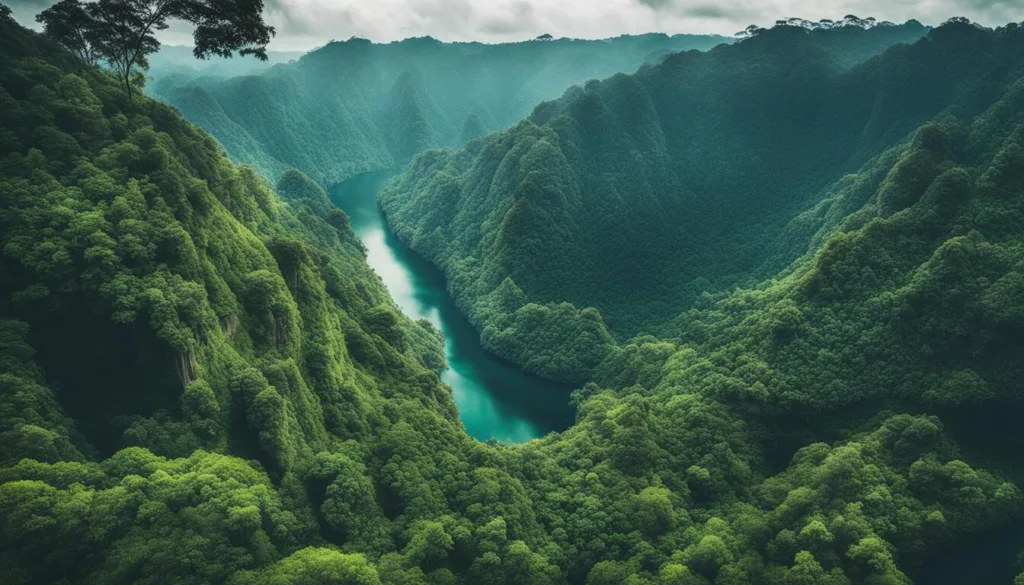
Table: Kalibiru National Park Quick Facts
| Location | Yogyakarta, Java Island |
|---|---|
| Elevation | Approximately 450 meters above sea level |
| Activities | Canopy walk, flying fox, trekking, photography |
| Views | Menoreh Hills, forests, distant mountains |
| Eco-friendly Initiatives | Recycling programs, responsible tourism practices |
| Recommended Visit | Half-day to full-day excursion |
Anyer Beach – A Serene Coastal Town
When it comes to serene beaches and a laid-back atmosphere, Anyer Beach in Banten, Java, is a hidden gem that offers the perfect escape from the hustle and bustle of city life. Located on the northwest coast of Java, this charming coastal town boasts picturesque scenery with palm trees swaying in the breeze and crystal-clear waters gently lapping at the shore. Whether you’re seeking relaxation or adventure, Anyer Beach has something to offer for everyone.
One of the highlights of Anyer Beach is its pristine beaches. The soft golden sands invite visitors to relax and unwind while soaking up the warm tropical sun. Take a leisurely stroll along the shore, feel the sand between your toes, and listen to the soothing sound of the waves crashing against the beach. The tranquil ambiance of Anyer Beach makes it the perfect place to escape from the stresses of everyday life and rejuvenate your mind and body.
For those seeking water activities, Anyer Beach offers a variety of options. Dive into the crystal-clear waters and discover a vibrant underwater world teeming with marine life. Snorkeling enthusiasts can explore the colorful coral reefs just off the coast, while adrenaline junkies can try their hand at thrilling water sports such as jet skiing or banana boating. Whether you’re a seasoned water enthusiast or a first-time adventurer, Anyer Beach has something to suit your preferences.
Table: Beach Activities at Anyer Beach
| Activity | Description |
|---|---|
| Sunbathing | Relax and soak up the sun on the soft golden sands of Anyer Beach. |
| Swimming | Take a refreshing dip in the crystal-clear waters of the beach. |
| Snorkeling | Explore the vibrant underwater world and discover colorful coral reefs. |
| Jet Skiing | Feel the adrenaline rush as you speed across the water on a jet ski. |
| Banana Boating | Hold on tight and enjoy a thrilling ride on a banana-shaped inflatable boat. |
Aside from its natural beauty, Anyer Beach also offers a laid-back atmosphere that allows visitors to escape the hustle and bustle of city life. Embrace the slow pace of the town and immerse yourself in the local culture. Indulge in delicious seafood freshly caught by local fishermen, or explore the nearby markets and taste the flavors of authentic Indonesian cuisine. Anyer Beach provides a unique opportunity to experience the warmth and hospitality of the local community.
So, whether you’re looking for a tranquil beach getaway or an adventure-filled vacation, Anyer Beach in Banten, Java, is the perfect destination. With its serene beaches, wide array of water activities, and laid-back atmosphere, it promises an unforgettable experience for all travelers seeking a tropical paradise.

Conclusion
As I conclude this journey through Java Island, it becomes clear that this tropical paradise is a haven for Indonesian tourism. With its hidden gems waiting to be discovered, Java offers a unique blend of natural wonders, rich history, and vibrant cultural experiences.
From the pristine beaches of Karimunjawa to the awe-inspiring temples of Borobudur and Prambanan, there is so much to explore on this enchanting island. Whether you are a beach lover, a history enthusiast, or an avid adventurer, Java has something to offer for everyone.
As you plan your visit to Java Island, be prepared to be amazed by its breathtaking landscapes, immerse yourself in its colorful traditions, and indulge in the warmth and hospitality of its people. Discover the hidden gems that lie within this tropical paradise and create memories that will last a lifetime.
FAQ
What is the history of Java Island?
Java Island has a rich history dating back centuries, with influences from ancient Javanese kingdoms, Dutch colonial rule, and Indonesia’s fight for independence.
Where is Java Island located?
Java Island is located in Southeast Asia and is a part of Indonesia. It is the most populous island in Indonesia and is home to cities like Jakarta, Yogyakarta, and Surabaya.
When is the best time to visit Java?
The best time to visit Java depends on your preferences. The dry season, from April to October, offers pleasant weather for exploring the island’s attractions. The wet season, from November to March, provides a more relaxed and budget-friendly experience. The transition months of March and November have favorable weather with fewer tourists.
What are the must-visit attractions in Java?
Java offers a range of unique attractions, including the Karimunjawa Islands for beach lovers, Kawah Ijen for the blue fire phenomenon, Borobudur Temple for history and culture enthusiasts, Prambanan Temple for architectural marvels, Bandung for its cool climate and shopping, Dieng Plateau for its ancient temples and volcanic landscapes, Merapi Volcano for trekking and local traditions, Kalibiru National Park for serene nature escapes, and Anyer Beach for a laid-back coastal experience.


